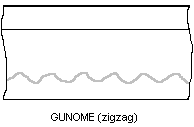Under the United States occupation at the end of World War II all armed forces in occupied Japan were disbanded and production of nihontō with edges was banned except under police or government permit. The ban was overturned through a personal appeal by Dr. Junji Honma. During a meeting with General Douglas MacArthur, Dr. Honma produced blades from the various periods of Japanese history and MacArthur was able to identify very quickly what blades held artistic merit and which could be considered purely weapons. As a result of this meeting, the ban was amended so that guntō weapons would be destroyed while swords of artistic merit could be owned and preserved. Even so, many nihontō were sold to American soldiers at a bargain price; in 1958 there were more Japanese swords in America than in Japan. The vast majority of these one million or more swords were guntō, but there were still a sizable number of older swords.
After the Edo period, swordsmiths turned increasingly to the production of civilian goods. The Occupation and its regulations almost put an end to the production of nihonto. A few smiths continued their trade, and Dr. Honma went on to be a founder of the Society for the Preservation of the Japanese Sword (Nippon Bijutsu Tōken Hozon Kyōkai), who made it their mission to preserve the old techniques and blades. Thanks to the efforts of other like-minded individuals, the nihontō did not disappear, many swordsmiths continued the work begun by Masahide, and the old swordmaking techniques were rediscovered.
Modern nihonto manufactured according to traditional methods are usually known as shinsakutō ( shinsakutō), meaning "newly made swords". Alternately, they can be termed shinken when they are designed for combat as opposed to iaito training swords.
Due to their popularity in modern media, display-only "nihontō" have become widespread in the sword marketplace. Ranging from small letter openers to scale replica "wallhangers", these items are commonly made from stainless steel (which makes them either brittle or poor at holding an edge) and have either a blunt or very crude edge. There are accounts of good quality stainless steel nihontō, however, these are rare at best. Some replica nihontō have been used in modern-day armed robberies, which became the reason for a possible ban on sale, import and hire of samurai swords in the UK.As a part of marketing, modern a-historic blade styles and material properties are often stated as traditional and genuine, promulgating disinformation.
In Japan, genuine edged hand-made Japanese swords, whether antique or modern, are classified as art objects (and not weapons) and must have accompanying certification in order to be legally owned. It should be noted that some companies and independent smiths outside of Japan produce katana as well, with varying levels of quality.



















